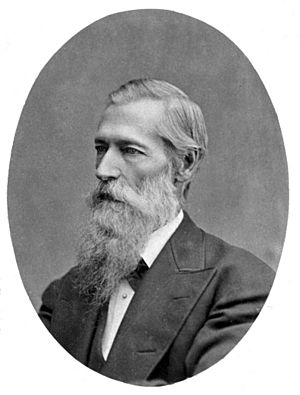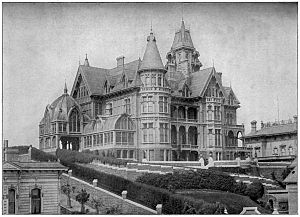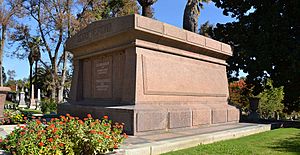Mark Hopkins Jr. facts for kids
Quick facts for kids
Mark Hopkins Jr.
|
|
|---|---|

Photo by I. W. Taber
|
|
| Born | September 1, 1813 |
| Died | March 29, 1878 (aged 64) |
| Resting place | Sacramento, California |
| Nationality | American |
| Occupation | Railroad investor & treasurer |
| Employer | Central Pacific Railroad |
| Known for | First Transcontinental Railroad |
| Net worth | US $20–40 million at the time of his death |
| Political party | Whig, Free Soil & Republican |
| Spouse(s) | Mary Frances Sherwood Hopkins |
| Parent(s) | Mark Hopkins (1779–1828) Anastasia Lukens Kellogg (1780–1837) |
Mark Hopkins (born September 1, 1813 – died March 29, 1878) was an important American businessman. He helped build the first Transcontinental Railroad across the United States. This huge railway connected the East and West coasts.
Mark Hopkins was one of the four main investors, known as the Big Four. They founded the Central Pacific Railroad in 1861. His partners were Leland Stanford, Charles Crocker, and Collis Huntington.
Contents
Early Life
Mark Hopkins was born on September 1, 1813. His birthplace was Henderson, New York. His parents were Mark Hopkins and Anastasia Lukens Kellogg. Sadly, his father died when Mark was still a boy.
In 1824, his family moved to St. Clair, Michigan. After his father passed away in 1828, Mark had to leave school. He started working as a clerk to help his family. He also studied law for a short time. Later, he tried different business jobs.
Moving to California
When the California Gold Rush started in 1849, many people rushed to California. Mark Hopkins decided to join them. He helped create a company called the "New England Mining and Trading Company." Twenty-six men each put in $500. They used this money to buy goods and ship them to California to sell.
Mark Hopkins left New York City on a ship called the Pacific. He sailed all the way around Cape Horn at the tip of South America. On August 5, 1849, his ship finally arrived in San Francisco.
Hopkins first opened a store in Placerville, California. But it didn't do very well. So, he moved to Sacramento. There, in 1850, he opened a wholesale grocery business. He started this with his friend Edward H. Miller. Miller later became an important secretary for the Central Pacific Railroad.
In 1855, Mark Hopkins teamed up with Collis P. Huntington. They formed a new company called "Huntington Hopkins and Company." This business sold hardware and iron in Sacramento.
Building the Railroad
In 1861, Mark Hopkins became one of the Big Four. These four men were the main founders of the Central Pacific Railroad. Their goal was to build a railway across the Sierra Nevada mountains. This railway would connect Sacramento, California, to Promontory, Utah.
People sometimes called Mark Hopkins "Uncle Mark." He was the oldest of the four partners. He was very well known for being careful with money. People even joked that he could "squeeze 106 cents out of every dollar!" Because of this, he became the company's treasurer.
Collis Huntington once said, "I never thought anything finished until Hopkins looked at it." This shows how much his partners trusted his judgment. Mark Hopkins was seen as the "balance-wheel" of the group. He helped keep everything steady and fair.
Mark Hopkins was also interested in politics. He was part of the Whig and later the Free Soil Party. He was against slavery and helped start the Republican Party in California.
Later Years and Death
Mark and Mary Hopkins did not have any children of their own. Mary adopted an adult son of her housekeeper, Timothy Nolan. He took the Hopkins name and worked for the Union Pacific Railroad.
Even though Mark Hopkins was very careful with money, his wife convinced him to build a grand house. This fancy mansion was built on top of Nob Hill in San Francisco. It was close to the homes of the other Central Pacific founders. Construction on the house began in 1875.
By 1878, Mark Hopkins was having health problems. He sadly passed away on March 29, 1878. He died on a company train near Yuma, Arizona. At the time of his death, his grand house was not yet finished. Mary Hopkins later moved into the completed mansion.
Sadly, the mansion was destroyed in a fire. This fire was caused by the 1906 San Francisco earthquake. In 1926, the InterContinental Mark Hopkins San Francisco hotel was built on the same spot.
Mark Hopkins is buried in the Sacramento Historic City Cemetery in Sacramento, California.
Images for kids
See also
 In Spanish: Mark Hopkins Jr. para niños
In Spanish: Mark Hopkins Jr. para niños






